Touch # Tone 38
CD in Digipak – 62:12
Artwork & Design: Jon Wozencroft
Recorded live at The Arnolfini, Bristol, 27th October 2007 by the doyen of sound recordists, Chris Watson, using 2 x Sony ECM 77s with a Nagra P11 Ares flash card recorder, and from desk to hard drive. The recording was mixed, edited and mastered by Touch stalwart BJNilsen, in Berlin during March 2009.
This concert was part of Touch 25 Live, which also featured a performance of Storm [by Chris Watson & BJNilsen]. Biosphere is Norwegian composer and performer Geir Jenssen, and this is his sixth release for Touch. In the early 1990s he was a pioneer of so-called “ambient techno”, but since then, he has refined his sound into something more magnetic and enduring. His last album, Dropsonde, wasn’t a soundtrack like the interwoven Substrata, nor an episodic journey in the way that Autour de la Lune is. It pushed new directions towards the jazz colors of Miles Davis and Jon Hassell, while re-invigorating the pulse and projection of his signature sound: a hypnotic combination of pleasure and dread. Here Geir Jenssen takes this further, incorporating samples of field recordings by Jony Easterby and trumpet by Anders Karlskås, invoking a sparser, more arresting sound. A landmark release for Biosphere, his first live album, heralding new beginnings without jettisoning the past…
Reviews:
Popmatters (USA):
8/10
In 2007, Biosphere—the primary vehicle of Tromsø, Norway’s Geir Jenssen—played a set at the Arnolfini Arts Center for Touch 25, a concert series commemorating the 25th anniversary of Jon Wozencroft’s Touch label. In a way, it was also a celebration of Biosphere’s own storied career, which began in 1991 and continues to this day. Jenssen is the recipient of a five-star rating on All Music Guide, and his 1997 LP Substrata is widely regarded as a classic of ambient techno. He composed the soundtrack to a Norwegian film, collaborated with scene stalwarts Deathprod and the Higher Intelligence Agency and kept his proper solo output coming at a respectable pace. Jenssen looked fame in the eye when his song “Novelty Waves” appeared in a Levi’s commercial in 1995, and then he turned away from it, choosing instead to satisfy himself with altering and updating his sparse panoramas of electronic gelidity.
If anything about Wireless has the air of a victory lap, it would only be because we believe that Jenssen now deserves to take one. But the music itself is modest, as it always has been, and the presentation lacks showmanship: Aside from the crisp breakbeat added to “When I Leave” (a nearly beatless track from 2000’s Cirque), Biosphere is laissez-faire with his material and keeps the mood quite tranquil. To this end, he has chosen his selections carefully: three pieces from his most recent full-length, Dropsonde (2006), two from Cirque, two from Substrata and the title track from 2002’s Shenzhou. (Wisely, he opted to leave out 2004’s uncommonly stony Autour de la Lune and his first two records, 1992’s Microgravity and 1994’s Dto, which are beginning to show its age.) The result is part career overview, part aural montage, with an emphasis on the kind of stirring, emotive drift that has represented the singular Biosphere experience for more than a decade.
The live setting puts an interesting spin on this music. A few songs lack the depth of its studio counterparts. “Birds Fly by Flapping Their Wings”, for example, was far more resonant and less uniformly mixed on Dropsonde than it is here, and it’s easy to detect the difference. But Biosphere’s material is intimately linked with the locale that Jenssen calls home, Tromsø, a city 500 miles north of the Arctic Circle, and Wireless gives the impression that it’s happening out on the ice somewhere, played loudly and from far away. You can almost feel the chilly European air swirling between the audience and the speakers. Besides hearing such beloved ambient standards as “Kobresia” wrapped in a unique package, the set’s real draw is “Calais Ferryport”, a previously unheard track that brings Jenssen’s production prowess to great heights. Longtime followers will find that the music holds up surprisingly well in a performance situation; likewise, Wireless is as good a place as any for newcomers to begin their journey into Biosphere’s extensive, alluring catalogue. [Mike Newark]
The Wire (UK):
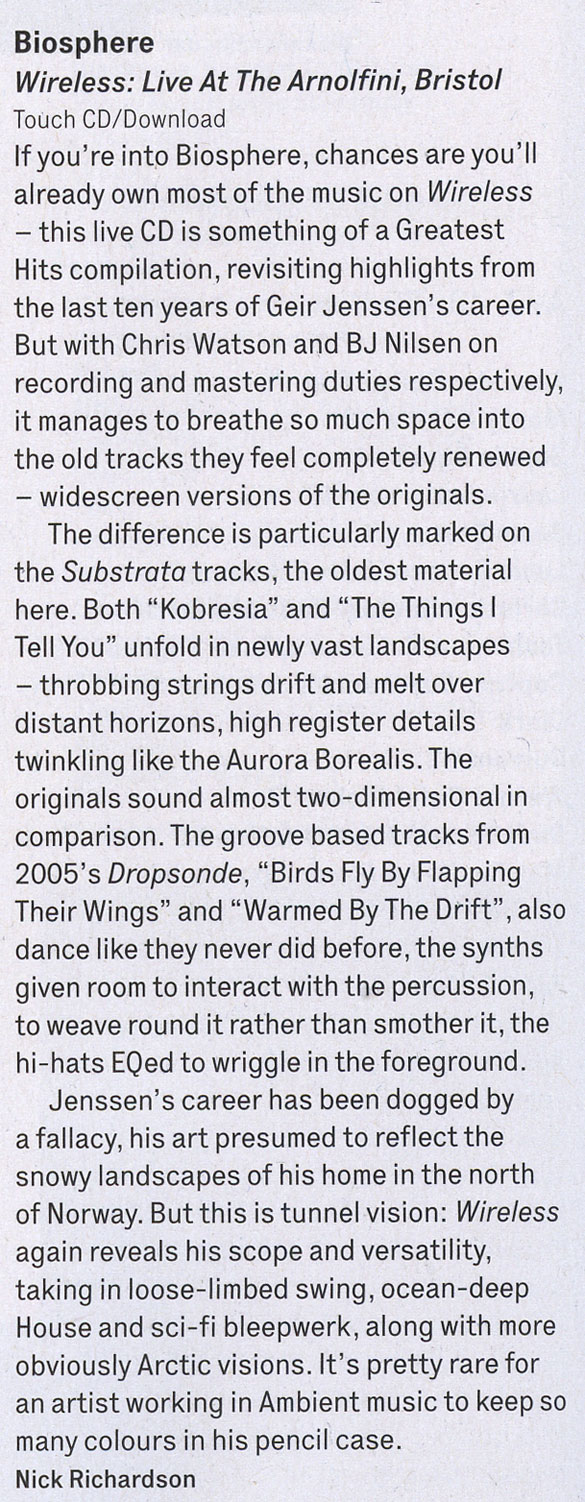
The Milk Factory (UK):
In 2007, the excellent Touch imprint celebrated twenty five years at the forefront of experimental music with a series of events across the UK and beyond involving some of the label’s most prominent artists. Recorded at the Arnolfini art centre in Bristol, as part of Touch25 Live, Biosphere’s Wireless, his first live album, documents Geir Jenssen’s work since he joined the Touch stable at the turn of the millennium. The set was arranged into an hour long track made up of compositions lifted from Jenssen’s albums for the label together with a handful of additional pieces.
Using material spanning eight years, from the seminal Substrata, originally released in 1997 on Origo Sound and All Saints and later re-issued on Touch, to Jenssen’s most recent output, Dropsonde (2005), all woven into one long piece, Wireless is a rich and cinematic soundtrack which develops into many directions, from the classical undertones of Shenzou to the field recordings of Pneuma or Moistened And Dried, the jazz echoes of Birds Fly By Flapping Their Wings or Warmed By The Drift or the vast ambient soundscapes of When I Leave or The Things I Tell You, yet feels exceptionally consistent and homogenous all the way through.
Opening proceedings is Pneuma, a minimal piece, based on what sounds like a respirator of some description but is in fact trombone sounds, played by Anders Karlskas, sounding not dissimilar to what Oren Marshall does with a tuba. This breathing apparatus effect is surprisingly reminiscent of some aspects of the sound document of Jenssen’s ascension of mount Cho Oyu, in Tibet, that he published on Touch’s sister label Ash International in 2006. As the warm tones of Shenzou slowly rises in the background, and finally takes over, the set reaches its natural ground and then drifts from one graceful moment to the next, Jenssen never letting the interest drop for one moment as he carefully regulates the flow of sounds and ambiences.
While each one of his albums has a very definite identity, the careful juxtaposition of tracks from different eras here actually works in the same way as Jenssen’s regular records, building a beautiful narrative from sounds sourced, for the most part, from nature, and arranged into evocative formations, some thriving on beat-less structures, others invigorated with subtle drum motifs. Here, like on his studio recordings, Jenssen voluntarily blurs the boundaries of each piece, leaving them to leak into the next, creating a seemingly flawless stream of music and sound.
Geir Jenssen is a truly accomplished performer who has, over the years, relentlessly worked at underlying the deep organic roots of his music, either through the widespread use of sounds sourced in nature, or through numerous installations across the world. This album demonstrates how his enveloping soundscapes become even more effective when performed live. Wireless is a superb document, not only of Geir Jenssen’s work, but also of the ethos that has made Touch one of the most singular and respected labels around. 4.9/5 [The Milkman]
Boomkat (UK):
The very first live album by that giant of ambient music Geir Jenssen, Wireless was recorded in Bristol’s Arnolfini during the Touch 25 live event of 2007. Jenssen’s set takes the form of a single hour-long continuous stream, indexed into eleven tracks. Wireless incorporates fresh material alongside retakes on a variety of sounds that’ll already carry some familiarity with followers of Biosphere studio albums: early on we’re treated to some of the exquisite Debussy sampling of Shenzou, and later on excerpts from Dropsonde and the classic Substrata crop up. Although culled from very different eras in electronic music, you never get the sense that lining up recent works next to nineties emissions presents any sort of technological anachronism, and Jenssen does a great job of imposing a new slant on his catalogue by weaving these pieces into a single, unfolding narrative. In this context the full breadth of Biosphere’s sonic palette is something to savour, taking in clipped orchestral movements, jazz-flecked technoid minimalism, abstract oceanic ambience, processed trombone passages, and on the absolutely ravishing ‘Calais Ferryport’ a cinematic concrete composition of the very highest order. Further to that, if for any reason you find yourself pondering the sound quality of this live album, you can most certainly rest assured that this is just about as refined a production as you could ever hope for: Chris Watson handled recording duties while BJ Nilsen undertook the mastering. You’d be extremely hard-pressed to find a better sounding live document anywhere. A massive recommendation.
Groove (Sweden):
Biosphere har sedan länge varit en av mina absoluta favoritartister, så när jag såg att han ger ut en ny skiva resulterade det i ett glatt utrop. Att det sedan visade sig vara en liveinspelning från 2007 sänkte dock mina förhoppningar en bit.
Wireless innehåller nästan bara gamla låtar. Bortsett från det inte alltför imponerande öppnings- och avslutningsspåret Pneuma, är det bara den fältinspelningsaktiga Calais Ferryport som är helt ny. I övrigt är det låtar från Dropsonde, Cirque, Shenzhou och Substrata som samsas om utrymmet. Det är en bra samling – det är bra låtar, utan tvekan – och trots att de spänner från samplingstung ambient electronica till droneaktiga fältinspelningar till loopbaserad minimalism, så fungerar de bra som en enhet. För den som inte redan har allt med Biosphere är det en oumbärlig introduktion. Men det hade ju varit ännu roligare med ett nytt album. [Henrik Strömberg]
The Norwegian Embassy in Paris (France):
Le label anglais Touch music publie l´enregistrement d´un concert du projet de musique électronique, Biosphere, qui a eu lieu à The Arnolfini à Bristol le 27 octobre 2007. Une belle occasion de découvrir ou de se replonger dans l´univers musical envoûtant de Geir Jenssen. 28/05/2009 ::
Ce concert faisait partie d´une série d´événements proposés pour les 25 ans du label Touch.
Après de nombreux albums – dont six publiés par Touch -, Geir Jenssen présente pour la première fois un enregistrement d´une performance lors de laquelle il joue des morceaux majeurs de ses albums Substrata, Cirque, Shenzhou et Dropsonde.
Originaire de Tromsø, Geir Jenssen sculpte depuis une vingtaine d´années la matière sonore. Après ses débuts avec le groupe Bel Canto, il fonde finalement Biosphere en 1991 et, tel un aventurier solitaire, se lance à la recherche de l´arctic sound dans l´album Microgravity en 1992. En quelques années, il forge son propre style – voire un nouveau courant musical – influençant un grand nombre d´artistes de la scène musicale électronique. Peu à peu sa musique explore des territoires plus abstraits et radicaux, sa palette de sons se veut plus minimale, plus complexe et atteint sa maturité avec l’album Substrata en 1997. Depuis, chaque album est une recherche singulière où il questionne sans relâche sa musique et sa façon de composer, mais toujours avec une sensibilité qui tient le rôle de fil d’Ariane dans sa discographie. Wireless permet d´avoir une vision d´ensemble de l´œuvre de Biosphere publiée par Touch – l’album Autour de la Lune mis à part puisqu´aucun morceau de cet album n´a été joué lors de ce concert à Bristol -, agrémentée de sons enregistrés par Jony Easterby et du trombone d´Anders Karlskås. La grande qualité de la « capture » de ce concert révèle aussi parfaitement le côté organique de cette musique ainsi que son pouvoir évocateur qui tend à rendre ténue la frontière entre rêve et réalité. [Yann Hascoet]
France Musique (France):
“Depuis plus de 25 ans le label Touch n’a de cesse de nous proposer des ¦uvres et des artistes exceptionnels, l’une de ces dernières éditions est un nouvel album de Biosphere enregistré en public à Bristol le 27 octobre 2007 au Arnolfini, haut lieu de manifestations consacré aux arts contemporains.Biosphere est le nom de scène du compositeur norvégien Geir Jenssen. L’artiste est ici enregistré à Bristol par le fameux Chris Watson (chasseur de sons de référence) et l’album a été mixé et masterisé par le musicien BJ Nilsen. Le grand truc de Biosphere consiste à livrer à nos oreilles les sons du monde, pas du monde dans sa globalité mais de son monde, celui des grands espaces de l’Arctique où cet artiste vit depuis son enfance, un monde qu’il a décidé de ne plus quitter après quelques tentatives plus au sud de l’Europe. Ce choix d’une vie dans des conditions climatiques de l’extrême se reflète dans la musique de Biosphere et ce nouvel album renouvele ce que Geir Jenssen fait le mieux : un savant mix de musique techno environnementale et minimale sur lequel le rythme, les voix et les ambiances sonores s’étirent , s’enchainent lentement et ouvrent la voie d’un parcours sonore toujours maitrisé. Avec son habituel sens de la lenteur, son refus de l’urgence et son regard musical particulièrement contemplatif, Biosphere nous offre (dans un confort d’écoute et sans jamais céder à la facilité) un autre regard sur le temps et l’espace, un regard qui nous fait si souvent défaut au cours de nos vies urbaines et agitées. A écouter et à apprécier sans limite et dans son intégralité.” [Eric Serva]
Musicreaction (France):
Il semblerait que l’ambient, ce genre aux frontières floues qui emprunte aussi bien au minimalisme qu’à la musique répétitive, aux musiques improvisées, à la concrète ou même à la techno, soit de retour en 2009. Il semblerait également qu’après les nombreuses rééditions des classiques de Geir Jenssen sous le nom de Biosphere, un artiste considéré comme un des pionniers de ce que l’on appelait l’ambient électronique dans les années 1990, ce retour en grâce soit largement positif pour l’artiste, tant au niveau de l’audience qu’au niveau créatif, puisqu’il sort aujourd’hui un live dont les climats doivent indéniablement à l’ambient de ses débuts, mais dont l’atmosphère est aussi rapidement happé par le jazz de Miles Davis et de John Hassel.
Enregistré live à l’Arnolfini de Bristol pour le label Touch, par l’ex-Cabaret Voltaire Chris Watson devenu spécialiste du field recordings, Wireless, “l’ambient sans fil” de Biosphere, s’étant dans des directions insoupçonnées, encore plus libre que d’habitude. Toujours secondé de ses machines mythiques, Jenssen fait également intervenir de véritables instruments joué live, en invitant par exemple Anders Karlskas au trombone. Un supplément de vie qui ne l’empêche pas de garder ses spécificité, comme l’intervention des paysages sonores, voix et bruits divers, capturés in situ au micro dans la nature par Jony Easterby. Tout simplement somptueux. [Maxence]
kindamuzik (Belgium):
De Noor Geir Jenssen is al meer dan vijftien jaar toonaangevend als grondlegger van de zogenaamde ambient techno. Met zijn alter ego Biosphere is hij op zoek naar het via organisch opgebouwde geluidslagen vormgeven van dromerig minimalisme. Bij iedere poging leidt dit tot andere vormen.
Na het minimalisme van Autour de la Lune en het lichtjes op jazz geïnspireerde Dropsonde luidt Biosphere met Wireless Š een nieuwe episode in. Zoals de titel aangeeft werd dit werkstuk live opgenomen in het kader van de festiviteiten van het vijfentwintigjarige bestaan van het label Touch. Chris Watson zat achter de knoppen en BJ Nilssen nam de mastering op zich – niet toevallig twee andere minimale elektronicagoeroes die Touch vaak als hun muzikale uitlaatklep gebruiken.
Het minimale van WirelessŠ zit niet in het schaarse gebruik van instrumenten, maar wel in de totaalsfeer waar uitgesponnen episodes elkaar organisch opvolgen. Jenssen is in de weer met samples en veldopnames, zodat er naar Biospheres gewoonte best een drukke structuur ontstaat waarin ritmes en geluiden elkaar opvolgen en de basis leggen voor nieuwe hoofdstukken in de ruim een uur in beslagnemende luistertocht.
Ook al is Wireless Š niet het hoogtepunt in Biospheres oeuvre, toch geeft het goed aan hoe Jenssen met nieuwe elementen tot een interessant resultaat komt zonder zijn aloude principes overboord te gooien. [Hans van der Linden]
Other Music (USA):
Now, I’ve never been a fan of live albums and I know I’m not the only one. For most artists the ‘live album’ has been a way to either cash-in or a way for fans to claim superiority over each other — I spent far too long in my youth trawling record fairs for the Holy Grail of Nirvana or Maiden shows (often on VHS) and I’ve been burnt too many times. So I can’t really say I was ecstatic at the prospect of a live album from Biosphere, an artist who I seldom equate with live performance. Then I noticed the small print — recorded by Chris Watson (possibly the world’s finest recordist) and mastered by BJ Nilsen. The main issue with most live albums is the pathetic sound; either it’s too clean or not clean enough, so these credentials intrigued me — and for good reason. The album is sonically stunning, as if you’re almost standing in the theater itself; the sound breathes through the speakers with an organic quality that’s impossible to recreate using standard recording methods. Wireless is one of those rare cases where the music actually sounds better than the original studio recordings — as Geir Jenssen steers us through his esteemed career (up to and including tracks from 2005’s Dropsonde), the tracks almost take on a life of their own. Most fans will have probably heard them before, but not like this as the synthesizers and drum machines echo and throb through the performance space, as cleanly as ice water. It’s a joy to hear from beginning to end, working as a distillation of Jenssen’s catalog, picking and emphasizing the best points of his influential career. More than just a curiosity, this is Touch’s suitably regal take on a ‘best of’ compilation, and what more could we expect from the label than them doing it in a way that nobody else could even attempt? Fantastic. [JT]
Ikonen (Germany):
Mit seinem mittlerweile sechsten Album für Touch fügt Geir Jenssen seinem umfangreichen Werk einen weiteren Live-Mitschnitt hinzu. Erinnerungen werden wach an das überwältigen-de “Polar Sequences”, das 1995 auf einem Berg oberhalb von Jenssens norwegischer Heimat-stadt Trømmo aufgenommen wurde. Nun also, im Jahr 2009, ist es das Arnolfini in Bristol: Und wieder einmal entführt uns “Wireless” in majestätisch schwebende Flächenlandschaften, in denen nur hin und wieder elektronische Bleeps oder leichte Percussions gegen die schein-bare musikalische Schwereloselosigkeit intervenieren (“Sherbrooke”). Der sparsame, überleg-te Einsatz von Sprachsamples (“Kobresia”), die ebenso unvorhersehbare wie souveräne Dra-maturgie aus erhabenen und abgründigen Passagen erinnert an Alan Wilders Recoil-Arbeiten. Dazu gesellen sich mal Schnipsel aus Feldaufnahmen (Jony Easterby), mal verfremdete Im-provisationen klassischer Instrumente (Anders Karlskås auf “Pneuma”). Früher nannte man Jenssen Tracks, z.B. “Novelty Waves” (1994) oder das Album “Substrata” (1997), noch “Ambient” oder – etwas ambitionierter – “Intelligent Techno”. Doch jenseits von Trade-marks, Genres und Etiketten ist “Wireless” einfach nur ein wunderschönes Album: Es schlägt die Sinne in Bann. [Oliver Keutzer]
VITAL (Netherlands):
No matter how hard I tried, but I can’t remember seeing the last Biosphere studio record, it must have been a while. Come to think of it, we didn’t review ‘Dropsonde’. What we do know is that ‘Wireless’ is the first live album by Biosphere, one of the master minds of ambient music. Starting out in ambient techno (releasing a classic with ‘Patashnik’ in 1994), and then moving out of the techno, deeper into the land of ambient music, leaving off any pulses at some point. On ‘Wireless’ he returns to use pulses and rhythms: minimal but not in a click n cut sense. Warm, fourth world alike. which guide the soft synths, field recordings and, for the first time around the trumpet of Anders Karlskas. As such this live album is not a distinct break with the ‘old’ Biosphere, the one calm sound tapestries on ‘Substrata’ for instance, but it seems to have come to a full circle now. The more simple, rhythmic samples refer to what I can call Biosphere ‘mark 1’, but not as dance oriented, more trance inducing, lay down, sit back music, whereas the deep atmospheric textures of before are still part of it, that has become a trademark of Biosphere. Changes in the sound of Biosphere are small, but crucial. ‘Wireless’ is once again a refined ambient from one of the true masters of the genre. [FdW]
Orkus (Germany):

Goon (Germany):
Der schwärmerische Geist
Der Norweger Geir Jenssen, besser bekannt als Biosphere, ist der heimliche Naturphilosoph der elektronischen Musikszene. Sein erstes Live-Album »Wireless« gibt einen guten Überblick über den Formenreichtum seines Schaffens
Geir Jenssen ist einer der wenigen Musiker, die bereits einen Achttausender bezwungen haben. So wissen wir spätestens seit seiner Veröffentlichung »Cho Oyu 8201m – Field Recordings From Tibet« aus dem Jahre 2006, was wir seit seinem ersten Album als Biosphere im Jahre 1991 bereits geahnt haben: Geir Jenssen ist Naturliebhaber und Musiker gleichermaßen. Es gibt keine Unterscheidung, Geist und Natur sind in einem unterschiedslosem »Absoluten« identisch. Seine Eindrücke von Feld und Wald, Nahe und Ferne sind bereits Musik. Wäre der 1962 in Tromsø geborene Musiker ein Maler, wahrscheinlich würde er sich voll und ganz der Landschaftsmalerei verschreiben. Die Reproduktion eines Naturerlebnisses in der Musik, ist allerdings noch eine ganz andere Herausforderung. »Wireless«, das erste Live-Album von Biosphere, zeigt nun eindrucksvoll, wie vielfältig die Möglichkeiten dieser Darstellung sind. So vielfältig wie die Schöpfung selbst, möchte man sagen. Aufgenommen am 27. Oktober 2007 im Arnolfini, Bristols weltweit bekanntes Zentrum für zeitgenössische Kunst, gibt Geir Jenssen hier einen guten Überblick über sein Schaffen, vom cineastisch-weiträumigen »Substrata« (1997), über seine Mondreise (»Autour de la lune«, 2004) zusammen mit Jules Vernes an Bord der Raumstation Mir, bis hin zu seiner Auseinandersetzung mit Jazz auf »Dropsonde« (2005). Die elf Nummern aus den verschiedenen Schaffensepochen werden von Geir Jenssen zu einem großen einstündigen Track verschleift. Wenn es an dieser Platte überhaupt etwas auszusetzen gibt, dann, dass die Übergänge mir nicht immer ganz gelungen erscheinen. Doch das ist eine Unwichtigkeit, während man dem beeindruckende Erlebnis einer Musik, welche die Natur in eine künstlerische Idee transformiert, teilhaben kann. [Sebastian Hinz]
de:bug (Germany):
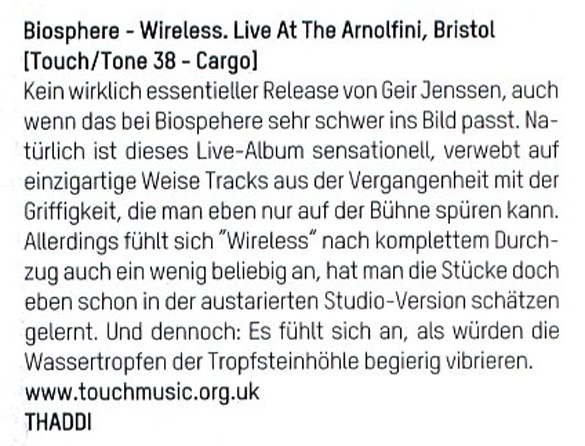
Sonic Seducer (Germany):
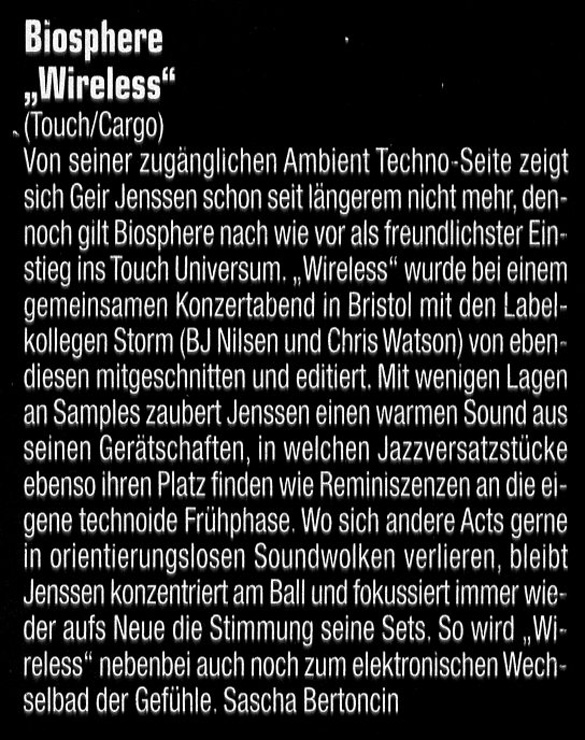
MCD (France):

Exclain (Canada):
First of all, turn your speakers way, way up because there’s little discernable noise for a minute or two into the first track of ambient maestro Biosphere’s first live disc. Even then you’d be hard-pressed to make out the experiments in trombone embouchure on “Pneuma.” However, like an expertly paced DJ set, the music gradually unfolds into a mix not unlike the kind the Orb used to make in the early ’90s, though without any possibility to dance your way out of the sonically-induced K-hole. The recording is a combination of hard disc board recording and live microphones, which gives a lovely sense of depth to the subtly undulating and swinging beats. Most of all, it’s Biosphere’s Northern chill that gives life to these varying shades of grey. For anyone familiar with the studio version of these songs, they will find much to love in the immense headroom gained by this process. Do not attempt to operate heavy machinery while listening to this recording. [David Dacks]
Octopus (France):
Cet album live de Biosphere est une véritable histoire de famille. Enregistré par Chris Watson, avec le matériel de haute précision qui convient, vous vous en doutez, mixé et masterisé par Bj Nilsen, cet enregistrement, réalisé en 2007, s’inscrit clairement dans la lignée des dernières productions, plus touffues et instrumentales, du maître norvégien. Si les nappes ambient polaires qui ont fait sa réputation sur des albums comme Substrata percent encore largement (“Birds fly by flapping their wings”), la musique se fait ici plus organique, dynamisée par les samples environnementalistes fournis par Jony Easterby (“Calais ferryport”), et par les interventions à la trompette d’Anders Karlskås (“Warmed by the drift”) qui étirent les ambiances vers des textures plus organiques, des situations sonores plus ambivalentes et mouvantes, évoquant autant les colorations jazz froides de certains disques de Miles Davis que les modulations fascinantes d’un Jon Hassell. Une ligne expectative forte, rehaussé des textures magnétiques déjà entendues sur l’album Dropsonde, et qui ouvre pour Geir Jenssen de nouvelles potentialités musicales. [Laurent Catala]
and
L’air de rien, ça fait bientôt vingt ans que Geir Jenssen aka Biosphere enchante nos nuits de ses projets mirifiques, le plus souvent à la frontière des musiques ambient et electronica, bien que ses tracks les plus courus (“Novelty Waves”, “Patashnik”) allaient clairement chercher du côté de l’IDM tendance Warp. Tourné définitivement dans d’élégantes atmosphères depuis son Substrata de 1997, signé – et ce n’était pas un hasard – sur le label All Saints Records de Brian Eno himself, le musicien de Tromsø était demeuré silencieux depuis 2006 et son Dropsonde, dernière production studio en date où un certain jazz fusion côtoyait des field recordings captés dans l’Himalaya. Quelques disques plus tard, dont les plus austères Shenzhou et Autour de la Lune, et désormais bien ancré sur le bateau Touch, le Norvégien se rappelle à notre – très – bon souvenir avec le présent Wireless – Live at the Arnolfini, Bristol, enregistré lors du concert qu’il donna le 27 octobre 2007 au centre d’art contemporain cité dans le titre. Après une brève introduction marquée du fer inquiétant d’une décompression pneumatique au sifflement suraigu (le trombone d’Anders Kalskås sur cet étonnant “Pneuma”), la performance prend un fascinant tournant mélodique répétitif, quelque part entre Debussy, Berio, Reich et Murcof, où les boucles samplées du grand compositeur français hantent jusqu’à l’hypnose (“Shenzou”). Véritable trésor de richesses aux multiples facettes (le spoken word russe, ambient sur Kobresia, IDM sur “When I Leave”), le disque prouve que la présence de son auteur tout au sommet de la hiérarchie mondiale tient autant à son génie des ambiances électroniques qu’à sa capacité narcotique de mêler les influences, du classicisme post-romantique au jazz fusion en passant par la dance music. Et vlan dans la tronche des Boards of Canada, et pan dans le bide d’Autechre!
[Fabrice Vanoverberg]
Rockerilla (Italy):
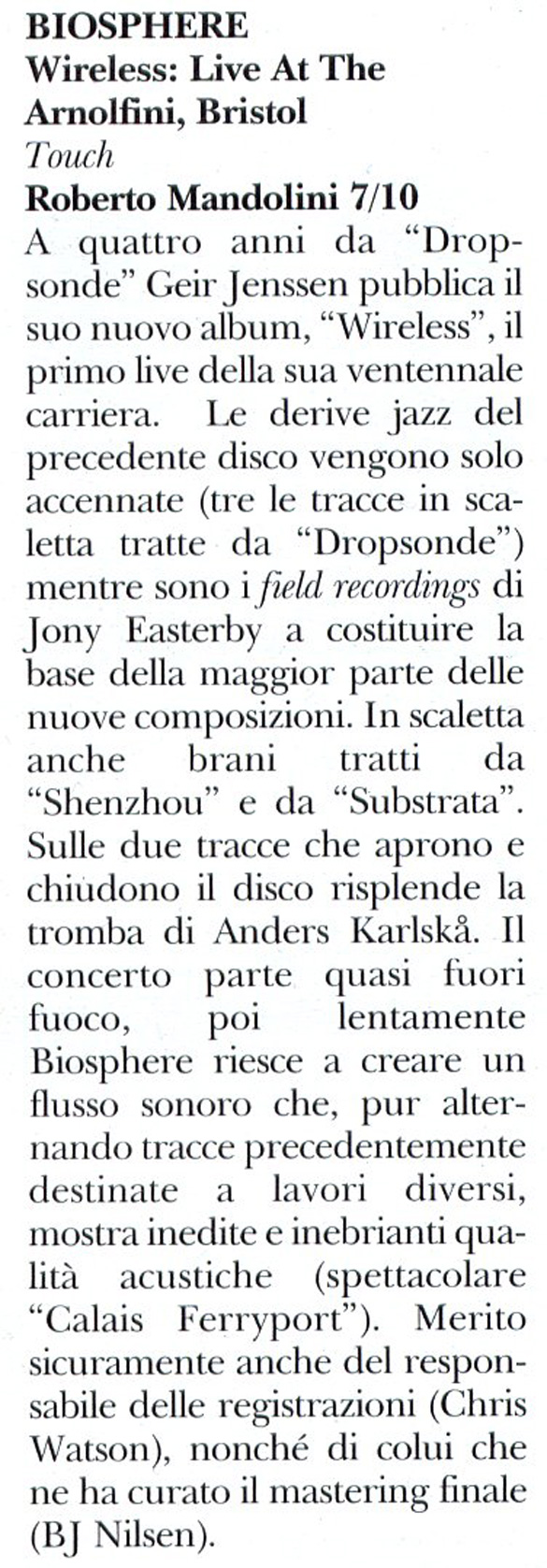
Laif (Turkey):
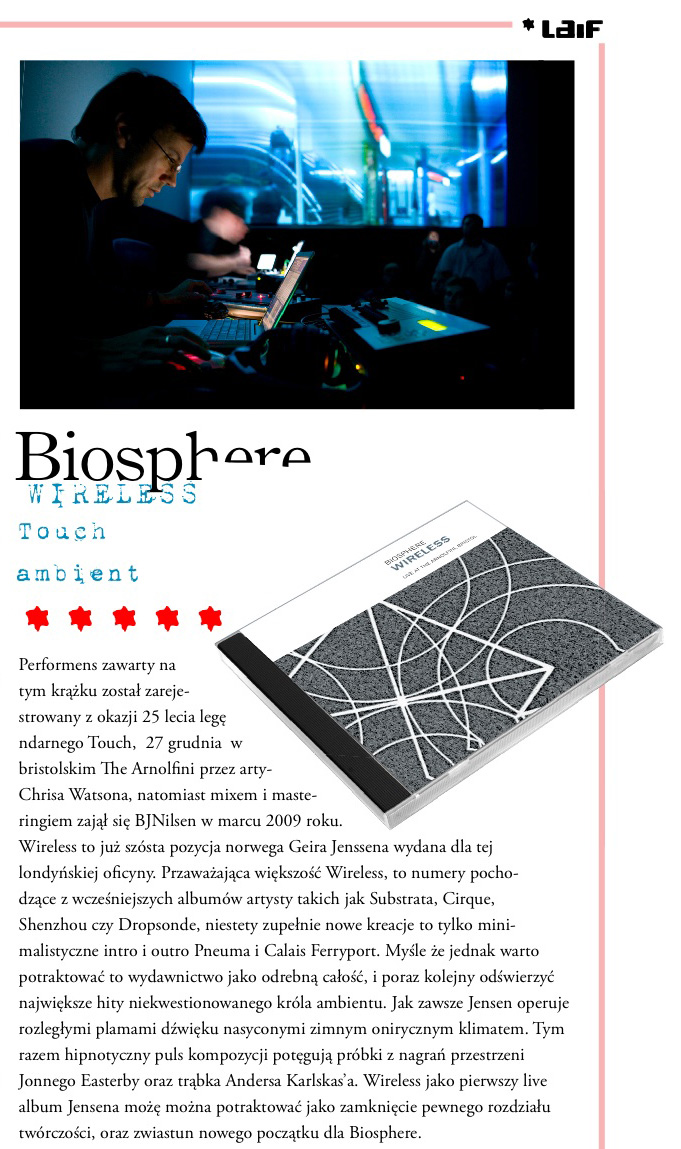
RifRaf (France):
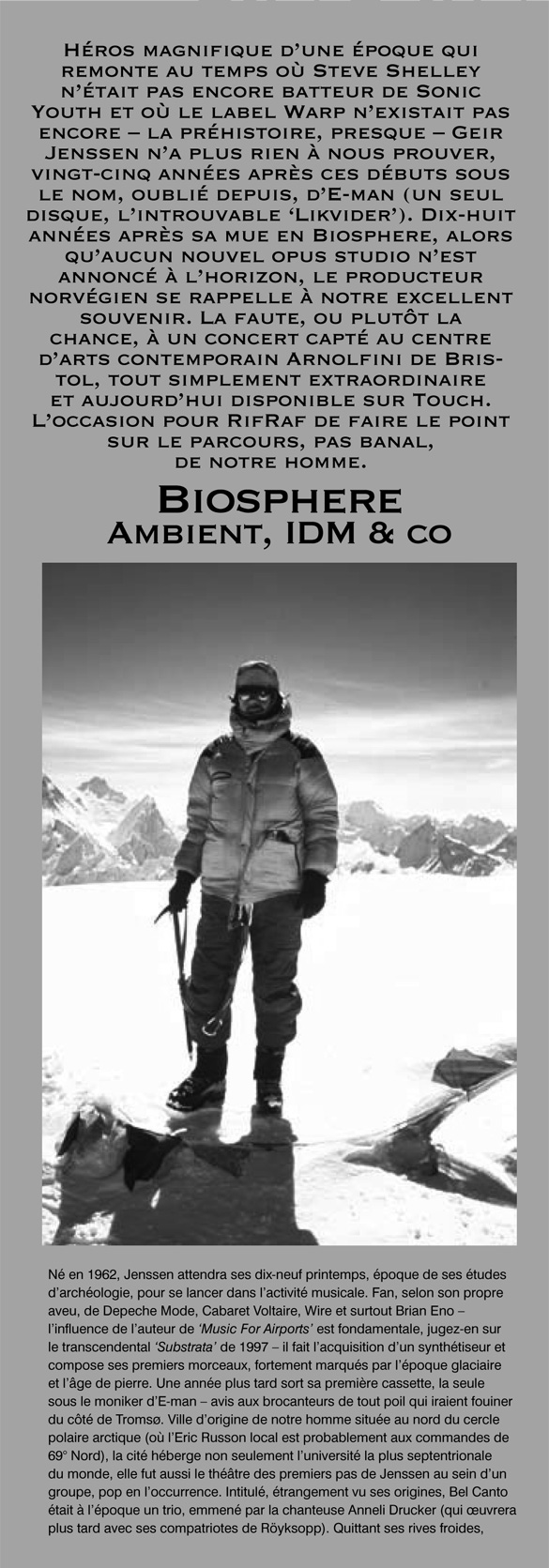

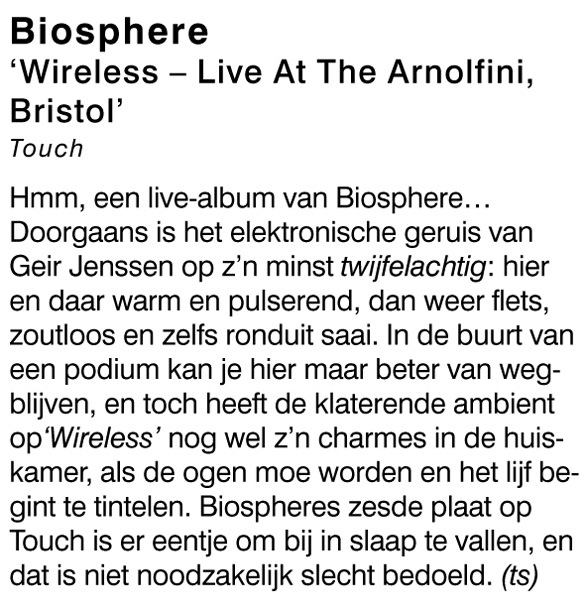
The Silent Ballet (USA):
Captivating an audience in the live arena is no easy task. Many bands today are able to hide un-inspiring music behind shouty showmanship and strong stage presence. “Yeah the songs were shit, but did you see the drummer jump off the scaffolding and fracture his skull? That was sweet… when’s their next gig?” However, the more cerebral acts out there are virtually naked on stage. It’s unlikely that Brian McBride of Stars of the Lid would smash his guitar over Adam Wiltze’s head; it just wouldn’t suit the mood. Musicians may use visual projections to compliment the sounds, but unless they‘re using images from Saw 8 or hard-core porn, they’re unlikely to distract the audience from the music. The task is made doubly difficult when presenting over sixty minutes of continuous sound. For anyone who’s familiar with his work, it should come as no surprise that Geir Jenssen (aka Biosphere) is able to pull off this nearly impossible feat with aplomb.
Arguably responsible for two of the finest ambient/electronic albums of the recent times in Substrata and Dropsonde, Biosphere returns with his first release in four years.
Performing as part of Touch25 Live (a series of concerts celebrating the great label’s twenty-fifth year) at The Arnolfini in Bristol back in 2007, Wireless is a sixty-two minute live recording made up familiar tracks and new work. An all-too-common problem with live albums is the sound quality; distorted sound mingled with the crowd noise often detracts from the energy of a live performance. However, this is not an issue on Wireless, as this is one of the finest live recordings I’ve heard. Kudos should be given to Chris Watson for his contribution mixing, and to Touch stalwart BJ Nilsen on editing and mastering duties. The result is a beautifully organic sound, without a trace of wooping or shouts of “Freebird!”
Those familiar with Biosphere will recognize tracks from each of his four albums recorded with Touch. Biosphere’s work displayed here spans eight years and many changes in the electronic music world. At first being described as “ambient techno”, Biosphere’s sound has progressively changed, eschewing his techno tag to move into more minimal and beatless realms. From the atmospheric electronics and eastern flavor of “Shenzou” to the jazz-influenced beats of Dropsonde (“Birds Fly by Flapping Their Wings” and “Warmed by The Drift” both appear on the record), the ambient soundscapes of “The Things I Tell You”, and “When I Leave”, with its Aphex Twin Selected Ambient Works II IDM feel, Jenssen is able to weave these differing styles into a one singular movement. This is no mean feat, and could be the single greatest achievement of the record. New material comes in the form of “Pneuma” and “Pneuma II” which bookend the record. These suggest a more abstract and sparse direction in the future, with “Pneuma I” featuring eerie tribal beats accompanied by whistling trombone sounds courtesy of Anders Karlskas. Although this serves as an intriguing opening to the piece, it lacks the beauty and depth of the rest of the album.
There are examples of great ambient live albums, with Fennez’s Live in Japan and Keith Fullerton Whitman’s fantastic Lisbon serving as two of the most obvious examples. What Wireless doesn’t do as well as these, and Lisbon in particular, is use the live performance as an opportunity to expand on the established tracks. The live versions are structurally nearly identical to the album versions, and only subtle changes have been made to give the album the homogeneous feel. As a result, this could reasonably be approached as a Biosphere “Best of” compilation, as it provides a great overview of the Norwegian’s work, and would be a decent jumping off point for anybody looking to investigate his back catalog. This, however, would be doing the record a disservice. Discard the tracklist (there isn’t one so that shouldn’t be hard) and clear your head. Listen to the this singular piece in one sitting and enjoy Biosphere’s varying visions, melded into one seamless narrative that will keep the audience enthralled right up until the sixty-second minute – without the need for broken bones. [Matt Fernell]
ADC (France):
Certains d’entre vous se souviennent peut-être de la pop aérienne distillée dans les années 80 par un groupe norvégien du nom de Bel Canto qui bénéficia alors d’un succès d’estime qui jamais ne se transforma en un réel succès commercialŠ Geir Jenssen, fondateur de Bel Canto, se lance alors, dés 1990, dans une direction musicale tout à fait différente sous le pseudonyme de Biosphere.
Au fil de ses albums (dont la majorité sortis sur l’excellentissime label anglais Touch Records), Geir explore des paysages sonores tout à la fois glacials (Norvège obligeŠ) mais lumineux et chaleureux. A ses débuts, les programmations rythmiques sont encore présentes mais très vite, Geir choisit une direction plus épurée, essentiellement composée de nappes sonores mouvantes et enveloppantes et de sons aériens voire cosmiques. Enregistré en live lors de son concert à l’Arnolfi de Bristol (UK) dans le cadre du Festival Touch 25 organisé pour célébrer les 25 ans de Touch Records, “Wireless” est une excellente introduction à l’univers magique de Biosphere puisqu’on y retrouve aussi bien des plages ambient profondes et envoûtantes que des passages « rythmés » mais là encore toujours dans la veine ambient propre à l’artiste “Wireless” est un voyage lent mais captivant dans des contrées boréales d’une pureté éblouissantes. [Maxine]
Blow Up (Italy):
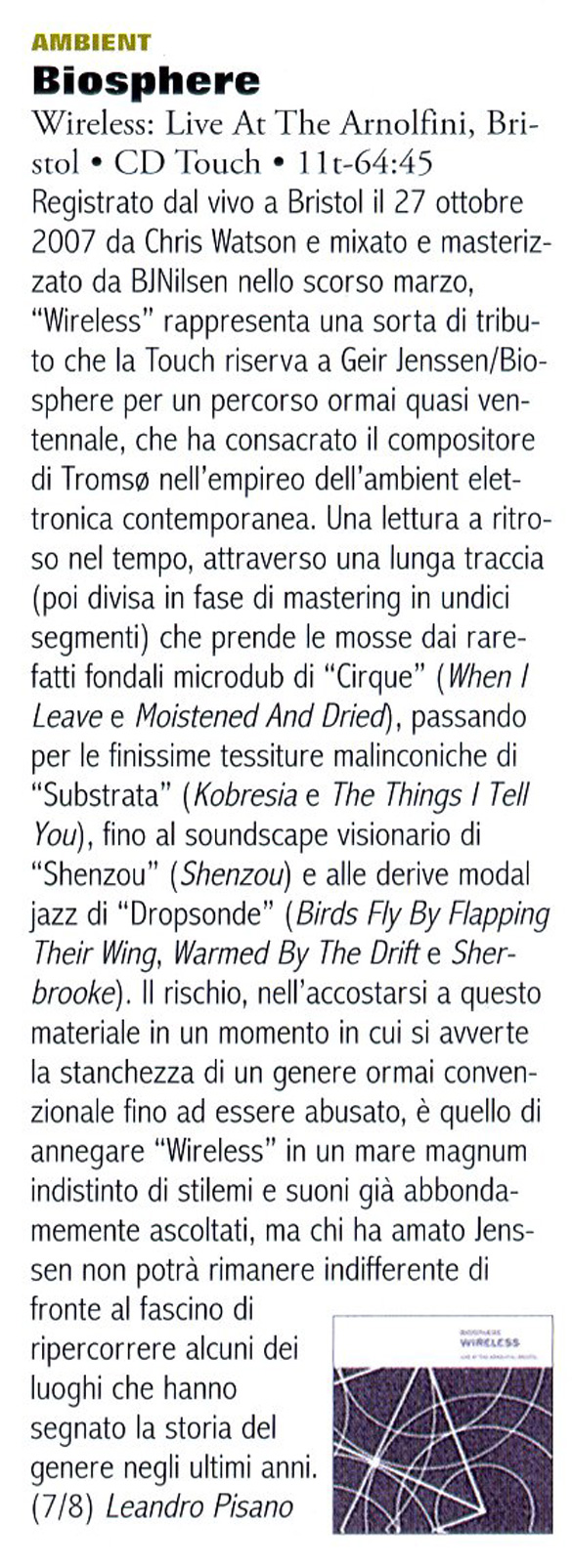
MCD (France):

GoMag (Spain):
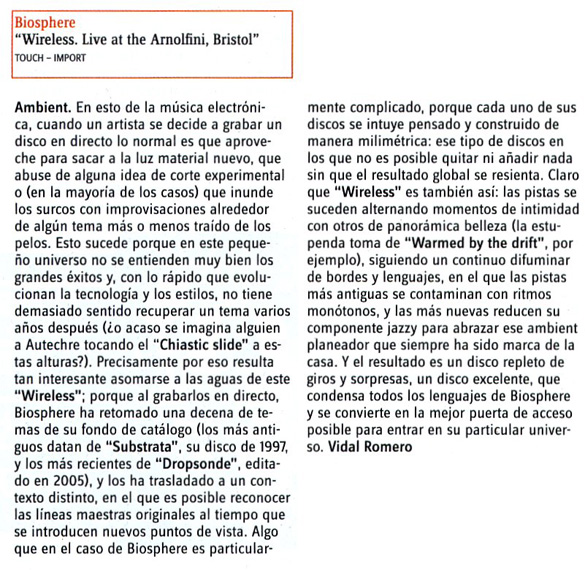
Skug (Austria):

Sound of Music (Sweden):
Biospheres skivor har jag följt noga men aldrig har jag sett honom spela live. En liveskiva är en klen ersättning, men på det sätt som den här konserten spelades in, kommer man ganska nära.
Bakom Biosphere står Tromsöbon Geir Jenssen, på 80-talet medlem i synthgruppen Bel Canto och sedan 90-talet soloartist med ett alldeles eget sound. Det har gått i vågor, men jag är fortfarande svårt förälskad i hans ambienta electronica. Om den norska frijazzen har Jan Garbareks fjordar att tacka för sin rymd och frihet, då är perfektionisten Biosphere med sina bortåt tio fullängdsplattor det vida, arktiska ljudets inspirerande landskapsarkitekt. Många har sökt men jag vet ingen som hittat en lika ren och avklarnad ljudpalett som Biosphere. Där finns gränslöst med utrymme för fältinspelningar, enkla repetitiva rytmer, ryska kosmonauter, jazzgrooves, orkestersamplingar, vibrerande trombonklaffar, djupdykande valar, rymdklanger, vinternätter, sommarnätter. Pretentiöst eller grandiost? Bådadera.
”Wireless – Live At The Arnolfini, Bristol” spelades in 2007 i samband med skivbolaget Touchs 25-årsfirande. Geir Jenssen gjorde ett timmeslångt set och vävde samman strukturer och fragment från gamla och nyare låtar. Där hörs hans klassiska Debussy-sampling från ”Shenzou”, utdrag från ”Dropsonde”, ”Substrata”, oändligt reverb från ”Cirque”, stormar och en pappersmugg i vinden från soundscapeplattan ”Cho Oyu”, inspelad under en bergsvandring i Tibet.
Det är, om någon trodde annat, en sällsynt välkomponerad timme Jenssen bjuder på. Ingen brådska. Inget frapperande. Skivan inleds och avslutas med trombonisten Anders Karlskås som blåser upp en större rymd med sina olika andnings- och speltekniker. Biospheres musik, som nästan uteslutande bygger på loopade rytmer hämtade från ovanliga sammanhang (en spröd fagott, en enkel pulsvåg) och infogade fältinspelningar, får ytterligare dimensioner av Chris Watsons liveinspelning. Watson, med förflutet i Cabaret Voltaire med fältinspelningar som sitt instrument, är som bekant framstående inspelningsartist inom soundscapes (flera skivor utgivna på Touch).
Till konserten med Biosphere bidrog Watson med ett liveljud – som faktiskt hörs. Musiken fångades nämligen inte bara från mixerbordet i Arnolfini Art Center i Bristol utan också med, för att vara exakt, två stycken Sonymikrofoner ECM 77 och en Nagrabandspelare P11. Mixat och mastrat har sedan BJNilsen gjort.
Ljudporr, visst, och skönt är det. En mer personlig liveinspelning får man leta efter. [Sven Rånlund]
Foxydigitalis (USA):
It’s strange to think that in all of Biosphere’s considerable discography that this would be his first live album, but it is. In addition, it seems more than appropriate that Chris Watson recorded the record—a perfectly organic collaboration between two prodigious artists, and was then mixed, edited and mastered by the equally gifted BJNilsen. The all-star Touch line-up amounts to a wonderful success on all levels.
This performance, part of Touch 25 Live captures Biosphere (Geir Jenssen) at his panoramic best. An acknowledged pioneer of natural sound sourcing and hypnotic beats, it’s difficult to capture in words the breadth of even one Biosphere outing—the work is so often breathtaking it borders on the sublime and ineffable.
Multi-layered, thoughtful and technically adept, the pulse of Biosphere is deceptively emotive. Navigating the cool exteriors, one soon discovers complex webs of pathos which lend the feel and meaning an almost paradoxical nature. Nowhere is that complexity better represented than on this live release. It’s nearly impossible to separate the music from our planet in peril, and in so doing often prompts fury at those who are so arrogantly dismissive of the damage we’ve done to our surroundings.
Perhaps, though, I’m simply being too subjective, too willing to cull intent, but Biosphere has always evoked a deep melancholy in me, much like the passage of time and its moribund connotation. While there are always inherent dangers in drawing strict critical parallels and direct meaning for any writer critically interpreting an artist’s work, it’s a risk I’m willing to take, and as with all Biosphere releases, as varied as they are, there’s a continuity, undeniable to my ears, which string his work, piece by piece, album to album, song to song to something like a tangible requiem for our dying world. There always seems to be a sad grace underpinning Jenssen’s work, so full of muted dread and borderline, yet barely perceptible chaos; I see no change in this live performance. For many artists, such unflinching consistency might be mistaken for static complacency, yet here in Jennssen’s capable hands, it’s quite the contrary. Biosphere has once again prevailed, both in keeping his music fresh and expanding his personal sonic language while maintaining a fully developed and ever-expanding aesthetic. Highly recommended. 9/10 [P. Somniferum]
Le Son du Grisli (France):
A Bristol à l’automne 2007, Geir Jenssen (ou Biosphere) reprenait en public ses travaux d’ambient vaporeuse, l’inspiration animée par son goût des grands espaces : Ciel et Asie.
Allant jusqu’à les rapprocher sur Shenzou, capsule spatiale chinoise changée en morceau d’atmosphère faite de boucles et de nappes enveloppantes, après avoir mis en branle pour l’atteindre une mécanique de souffles sortis d’un trombone (Pneuma). La suite, d’osciller au gré des chocs sonores plus ou moins bien amortis : les maladresses prenant les noms de When I Leave (rythme peu subtil, enregistrement vocal agaçant d’avoir été trop entendu), Birds by Flapping Their Wings (boucle moins maligne) ; les réussites, ceux de Kobresia (guitare en perpétuelle décalage), Warmed The Drift (basse insistant sur deux notes), Moistened and Dried ou Calais Ferryport (ambient relevé d’un peu d’expérimental et transport avalé par un amas de field recordings).
Entre les deux, Jenssen assure le minimum, et d’un Pneuma à l’autre (Pneuma II), de l’ouverture à la conclusion de Wireless, l’auditeur estimera le chemin parcouru selon l’humeur du jour : goûtant les morceaux de choix avant d’être irrité, ou relativisant les écarts en comptant sur la surprise.
Clone (Spain):

Trax (Spain):
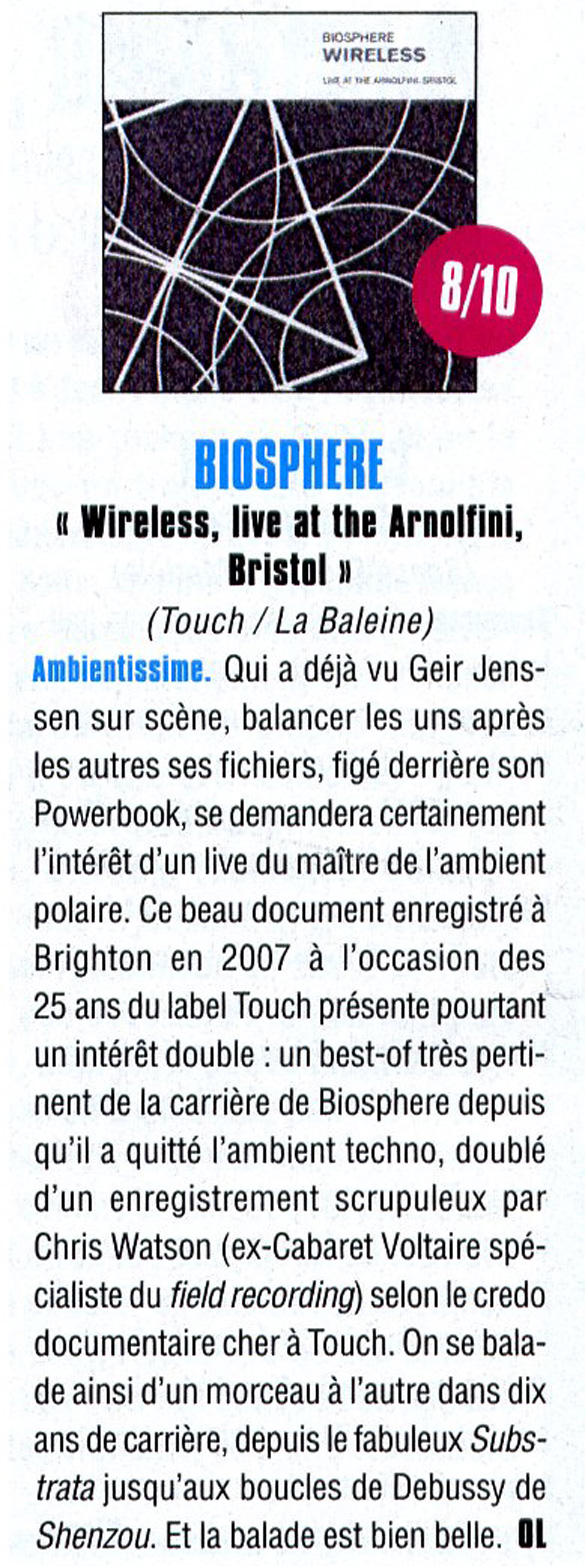
D-Side (France):

Dusted (USA):
Give Geir Jenssen credit for not staying still. Ever since the Norwegian electronicist made the financially dubious decision to drop out of Bel Canto 20 years ago and began following the path that led him to perform under the name Biosphere, he’s let his music develop at its own rate and done fundamentally what he wanted to do. While this hardly seems like a recipe for success given the short half-life of electronic music trends, it has paradoxically contributed to his longevity; by not playing the game of keeping up with the latest beats, he invites fans to instead keep up with him.
But he might be asking a bit too much of them with Wireless. Not that it’s a terribly demanding listen; quite the contrary, it’s a quintessential live album. Recorded in October 2007 and released 19 months later, it samples a decade of Biosphere music in typical greatest hits fashion. Its 11 tracks take you through Jenssen’s various stages – chill-out facilitator, textural sculptor, sonic appropriator, and atmospheric tunesmith. And it represents each phase with Touch Music’s usually scrupulous attention to audio and visual satisfaction; one labelmate, environmental sound documenter Chris Watson recorded the concert, and another, BJ Nilsen (a.k.a. Hazard), mastered it.
But all that plush sound cultivation points up a problem; not all Biosphere music is created equal. “When I Leave’s” upfront beats and obvious loops seem awfully simplistic when heard near “Calais Ferryport’s” rich layers of environmental and electronic sound. And when you A-B the tracks from Biosphere’s last studio record Dropsonde with their Wireless reproductions, they just don’t sound that different. Do you really need a souvenir for an event that in all likelihood you did not attend? If so, Wireless awaits you. But if you want to hear Biosphere at the top of his game, try Autour de la Lune instead. [Bill Meyer]
Rumore (Italy):
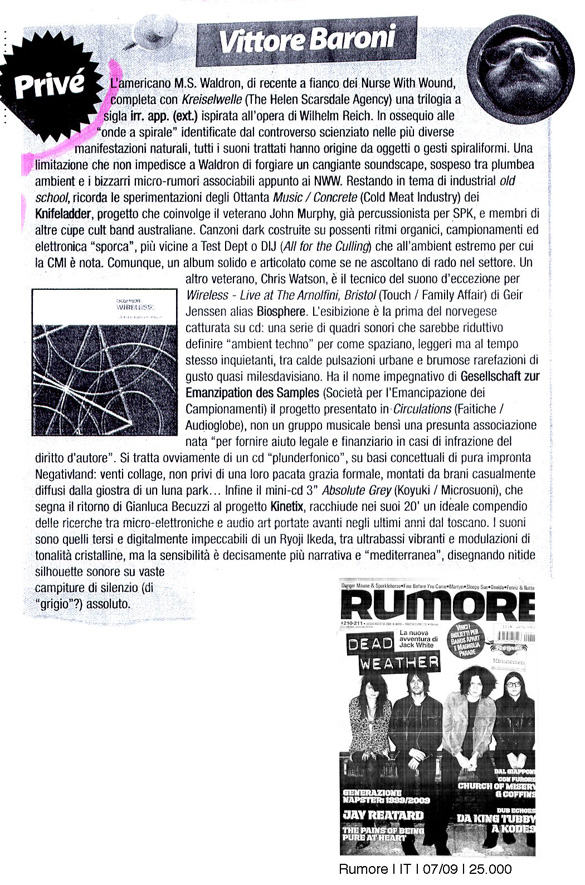
Rock & Pop (CZ):
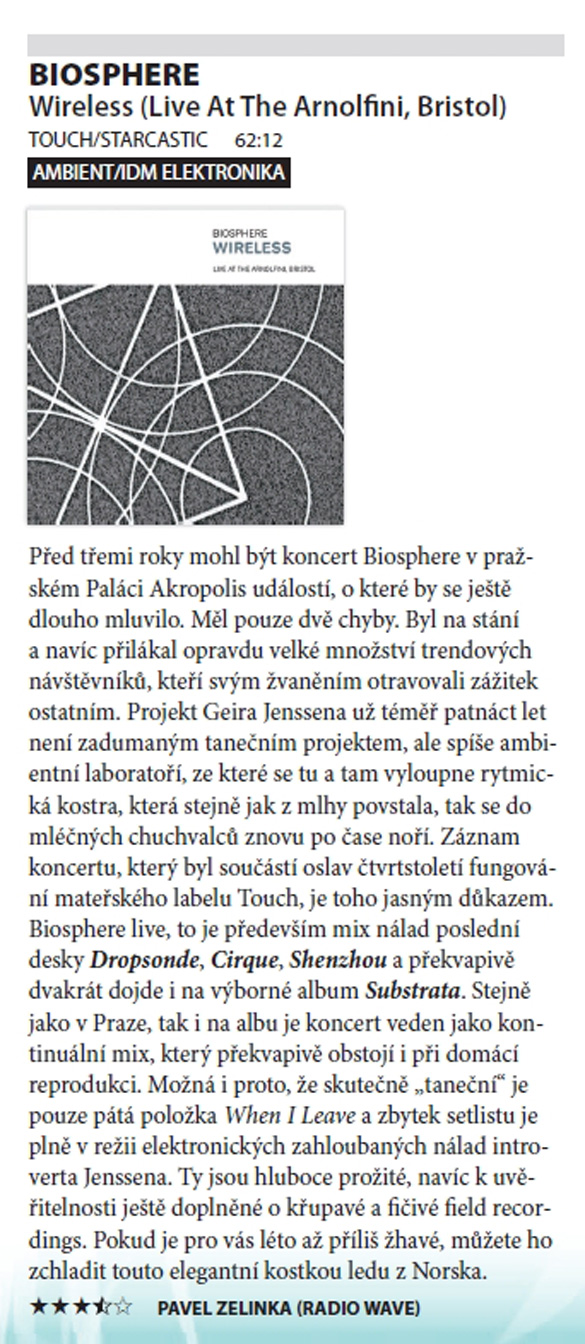
freiStil (Germany):
Noch wird Branchen-intern gerätselt, ob die multiplen Klangarbeiten von Biosphere als Abstract, als Minimal, als Ambient oder vielleicht doch als Intelligent Techno verkauft werden sollen, da bewegt sich Geir Jenssen – unbeeindruckt von derlei Marktmechanismen – längst von dort weg, weiter über benachbarte Grauzonen und Unschärfen, bis hin zu ganz anderen, noch gar nicht etikettierten Gefilden. Biosphere‘s erstes Live-Album, aufgenommen in Bristol/UK als Teil der 25-Jahre-Feierlichkeiten des Touch-Labels, sein sechstes für Touch, erzeugt durch die logische, eigentlich zwingende Dramaturgie eine nicht zu unterschätzende Sogwirkung. Unter raffinierter Einarbeitung diverser field recordings von Jony Easterby und des Posaunensounds von Anders Karlskas schlägt die rhythmische Strukturierung dem tendenziell stillen Fass den Boden aus. Wir hören hier eine hübsch durchmischte Menge an allerhand attraktiven Resonanzen: experimentelle Elektronik mit einem warmen Herzschlag, sphärische Landschaften mit tanzbarer Bodenhaftung, glasklare Disziplin mit viel Soul – exemplarisch vereint in Track #6, „warmed by the drift“. Kurz gesagt, ein zauberhaftes Album. Wären Benotungen nicht mit Fug und Recht verpönt, es regnete für „Wireless“ lauter Einser … [felix]
Bad Alchemy (Germany):
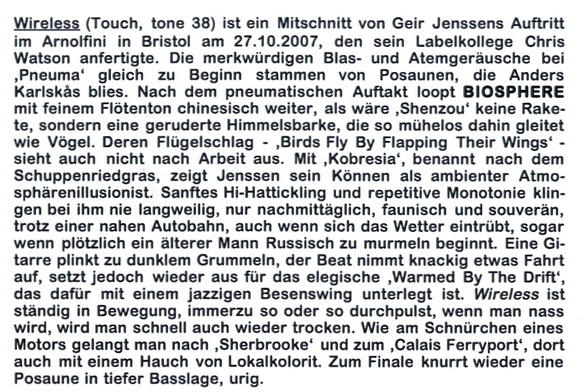
Exclaim (Canada):
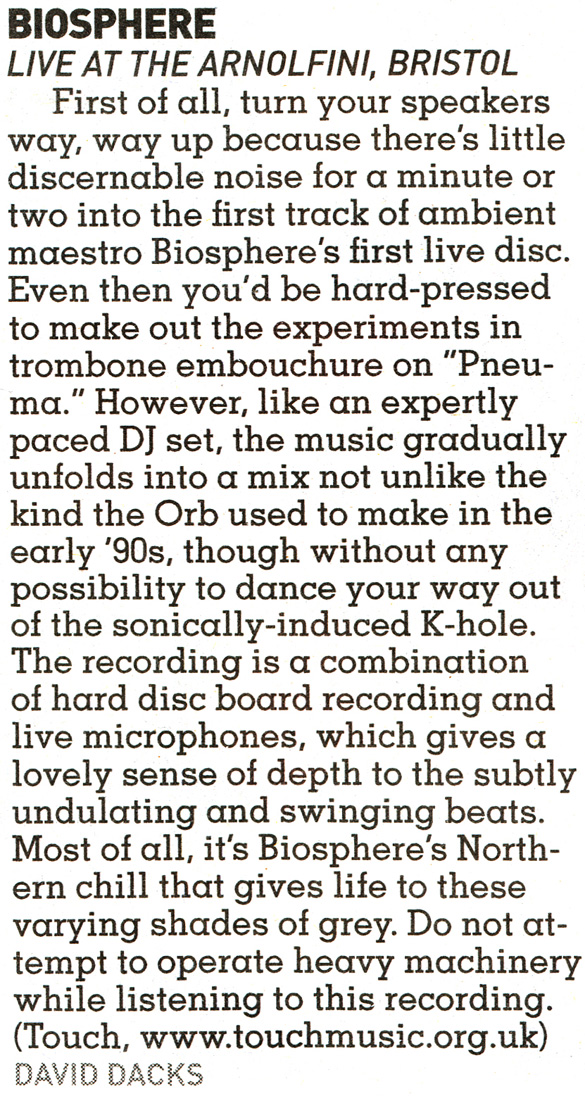
Temporary Fault (France):
Or, if you will, Live At The Arnolfini, Bristol. Admittedly, an on-site performance by a man who’s considered a master of meticulous aural construction (and whose music usually strikes for its impressively uncontaminated luminosity) got me halfway through curiosity and refusal – I am gradually, inexorably shifting my preference to studio-generated recordings – but class being class Geir Jenssen knows how to deliver rewarding soundscapes even in such a circumstance. This CD comprises a concert recorded in 2007 during the Touch 25 festival by what the press release calls “the doyen of sound recordists, Chris Watson”. A few tired moments aside (those pre-taped voices are not inexplicably enthralling as perhaps Biosphere desired, indeed taking a portion of magic away from the overall mood when they appear, and certain synthetic rhythm patterns dangerously approach kitsch) Jenssen manages to appear great as usual with his fantastic loops, among the most mesmerizing one can hear today, in essence confirming to have (almost) everything under control in every occasion. Wireless is not a chef d’oeuvre, and probably doesn’t belong in the artist’s top five. Still, it was played thrice in two days, so that must mean something.
Freistil (Germany):

The Silent Ballet (USA):
Captivating an audience in the live arena is no easy task. Many bands today are able to hide un-inspiring music behind shouty showmanship and strong stage presence. “Yeah the songs were shit, but did you see the drummer jump off the scaffolding and fracture his skull? That was sweet… when’s their next gig?” However, the more cerebral acts out there are virtually naked on stage. It’s unlikely that Brian McBride of Stars of the Lid would smash his guitar over Adam Wiltze’s head; it just wouldn’t suit the mood. Musicians may use visual projections to compliment the sounds, but unless they‘re using images from Saw 8 or hard-core porn, they’re unlikely to distract the audience from the music. The task is made doubly difficult when presenting over sixty minutes of continuous sound. For anyone who’s familiar with his work, it should come as no surprise that Geir Jenssen (aka Biosphere) is able to pull off this nearly impossible feat with aplomb.
Arguably responsible for two of the finest ambient/electronic albums of the recent times in Substrata and Dropsonde, Biosphere returns with his first release in four years.
Performing as part of Touch25 Live (a series of concerts celebrating the great label’s twenty-fifth year) at The Arnolfini in Bristol back in 2007, Wireless is a sixty-two minute live recording made up familiar tracks and new work. An all-too-common problem with live albums is the sound quality; distorted sound mingled with the crowd noise often detracts from the energy of a live performance. However, this is not an issue on Wireless, as this is one of the finest live recordings I’ve heard. Kudos should be given to Chris Watson for his contribution mixing, and to Touch stalwart BJ Nilsen on editing and mastering duties. The result is a beautifully organic sound, without a trace of wooping or shouts of “Freebird!”
Those familiar with Biosphere will recognize tracks from each of his four albums recorded with Touch. Biosphere’s work displayed here spans eight years and many changes in the electronic music world. At first being described as “ambient techno”, Biosphere’s sound has progressively changed, eschewing his techno tag to move into more minimal and beatless realms. From the atmospheric electronics and eastern flavor of “Shenzou” to the jazz-influenced beats of Dropsonde (“Birds Fly by Flapping Their Wings” and “Warmed by The Drift” both appear on the record), the ambient soundscapes of “The Things I Tell You”, and “When I Leave”, with its Aphex Twin Selected Ambient Works II IDM feel, Jenssen is able to weave these differing styles into a one singular movement. This is no mean feat, and could be the single greatest achievement of the record. New material comes in the form of “Pneuma” and “Pneuma II” which bookend the record. These suggest a more abstract and sparse direction in the future, with “Pneuma I” featuring eerie tribal beats accompanied by whistling trombone sounds courtesy of Anders Karlskas. Although this serves as an intriguing opening to the piece, it lacks the beauty and depth of the rest of the album.
There are examples of great ambient live albums, with Fennez’s Live in Japan and Keith Fullerton Whitman’s fantastic Lisbon serving as two of the most obvious examples. What Wireless doesn’t do as well as these, and Lisbon in particular, is use the live performance as an opportunity to expand on the established tracks. The live versions are structurally nearly identical to the album versions, and only subtle changes have been made to give the album the homogeneous feel. As a result, this could reasonably be approached as a Biosphere “Best of” compilation, as it provides a great overview of the Norwegian’s work, and would be a decent jumping off point for anybody looking to investigate his back catalog. This, however, would be doing the record a disservice. Discard the tracklist (there isn’t one so that shouldn’t be hard) and clear your head. Listen to the this singular piece in one sitting and enjoy Biosphere’s varying visions, melded into one seamless narrative that will keep the audience enthralled right up until the sixty-second minute – without the need for broken bones. [Matt Fernell]
GMD (France):
Si l’on peut maintenant parler sérieusement d’ « ambient techno », il ne faut jamais oublier que Biosphere en fut l’un des pionniers les plus marquants dans ce satané début des années 90, aux côtés notamment d’un autre doux rêveur mieux connu sous le nom de GAS (ou Wolfgang Voigt c’est selon, qui, avec Nah Und Fern réinventa au milieu de la décennie l’art électronique minimal). Mais Biosphere c’est aussi des road-movies en haute altitude, des monuments à classer au rang de patrimoine ambient (Autour De La Lune, Substrata) ; bref Biosphere, c’est avant tout une patte unique au c¦ur du silence musical. Heureux donc seront les fans qui découvrent ici le premier enregistrement live du producteur norvégien, produit d’un concert donné en 2007 en l’honneur de son label, le géant Touch.
Si la musique ambient est avant tout une histoire de ressenti, l’expérience live du genre reste un moment de pur dépucelage auditif, un tracé qui s’avère facilité pour autant que son géniteur soit investi de quelques dons chamaniques pour vous emmener dans la transe. Nul ne possède mieux que Geir Jenssen les prérequis nécessaires pour investir la pièce d’un son enivrant et profondément évocateur. Ces qualités doivent tout à l’approche techno de son hôte, qui travaille les nappes avec un dynamisme qu’on imagine tout droit extirpé d’un paysage techno-dub. Soyons clairs, il s’agira bel et bien d’ambient dans la forme, mais cette vigueur et cette fraîcheur défie à un point tel les codes du genre qu’on serait presque tentés d’y voir là un regret techno. En effet, les percussions sont retenues en cage et ne s’échappent que rarement (« When I Leave », « Warmed By The Drift », que n’aurait pas renié le dubstep de Scuba) ; les nappes sont hautes et millimétrées à la manière d’un The Field qui n’aurait plus rien à apprendre du 21ème siècle (« Birds Fly By Flapping Their Wings », « Sherbrooke ») quand les samples ne sont pas carrément technoïdes façon Detroit («The Things I Tell You », « Moistened and Dried »).
Qu’il s’agisse d’une coïncidence ou non, cette prestation a été donnée à Bristol et transpire le vent techno, la froideur glacée du dub-ambient et les nouvelles cultures de la basse anglaise. C’est là que Biosphere est grand car il enferme la substance électronique pour nous la resservir en jaillissements ambient, il parle à ce qui se trouve derrière l’entité techno, à son c¦ur et à son esprit éternel. Biosphere connaît ces lieux comme son corps, et s’y perd comme nos têtes, sans demander plus à la musique électronique que tout ce qu’elle lui a déjà donné : une âme, une sensibilité et une universalité qui se retrouve toujours au-delà des mots, coincées entre un kick qui n’arrivera jamais et une salle bouche bée à l’unisson. Chapeau l’artiste. 7/10
[Simon]
Etherreal (France):
Tiens, un nouvel album de Biosphere… chic !!
Oh et puis ça va nous changer, il s’agit d’un live, le genre de chose qui manquait justement à le discographie de Geir Jenssen, même si beaucoup se demanderont, à raison, quel est l’intérêt d’un tel album chez un artiste dont les prestations live ont peu de différences avec ses albums studio. En ce qui nous concerne on y verra un témoignage des concerts donnés courant 2007 et début 2008, avec un set particulièrement proche de ce que l’on pouvait voir à La Géode en janvier 2008.
Tous les spécialistes Touch du field recording sont représentés ici puisque ce concert donné à Bristol en octobre 2007 a été enregistré par Chris Watson selon ses méthodes habituelles, à savoir aux micros et non pas à la console, le résultat de ces enregistrements ayant ensuite été édité et masterisé par BJ Nilsen. Moins surprenant, c’est toujours Jon Wozencroft qui est responsable de la couverture, mais dans un style très différent de ses précédents travaux et qui semble marquer un virage chez Touch, en confirmant cette nouvelle approche graphique sur les albums de Robert Hampson et Mika Vainio dont nous parlerons prochainement.
La petite surprise de ce Wireless, elle se situe en ouverture et clôture de concert, avec la participation de Anders Karlskås aux trombones, ne produisant que des souffles, expirations, et claquements des clapets de son instrument, soit une introduction véritablement acoustique avec Pneuma. Par la suite on se retrouve en terrain connu, revisitant 10 ans de production musicale du Norvégien avec des titres extraits de Substrata, Cirque, Shenzou et Dropsonde, donnant à ce live l’aspect d’un best of, avec tout de même comme grand absent l’album Autour de la Lune.
En contrepartie, on trouve un inédit avec Calais Ferryport, et un travail un peu différent de ses productions habituelles, très basé sur des field recordings à peine édités, petit à petit envahis de nappes synthétiques, mais laissant globalement apparente l’origine de ses sons, ici plus urbains que d’accoutumée. Environ une heure de rêveries planantes, et puis Pneuma II qui nous permet de retrouver Anders Karlskås avec cette fois de graves et lourdes notes de trombones, semblant imiter le départ d’un ferry, et signifiant à l’auditeur que le voyage est terminé.
Certes, pas de grosse surprise, mais ce n’est pas ce que l’on attend non plus de Geir Jenssen. Wireless est une valeur sûre pour les fans du Norvégien, un très plaisant best of live. 7/8 [Fabrice Allard]
Rockdeluxe (Italy):
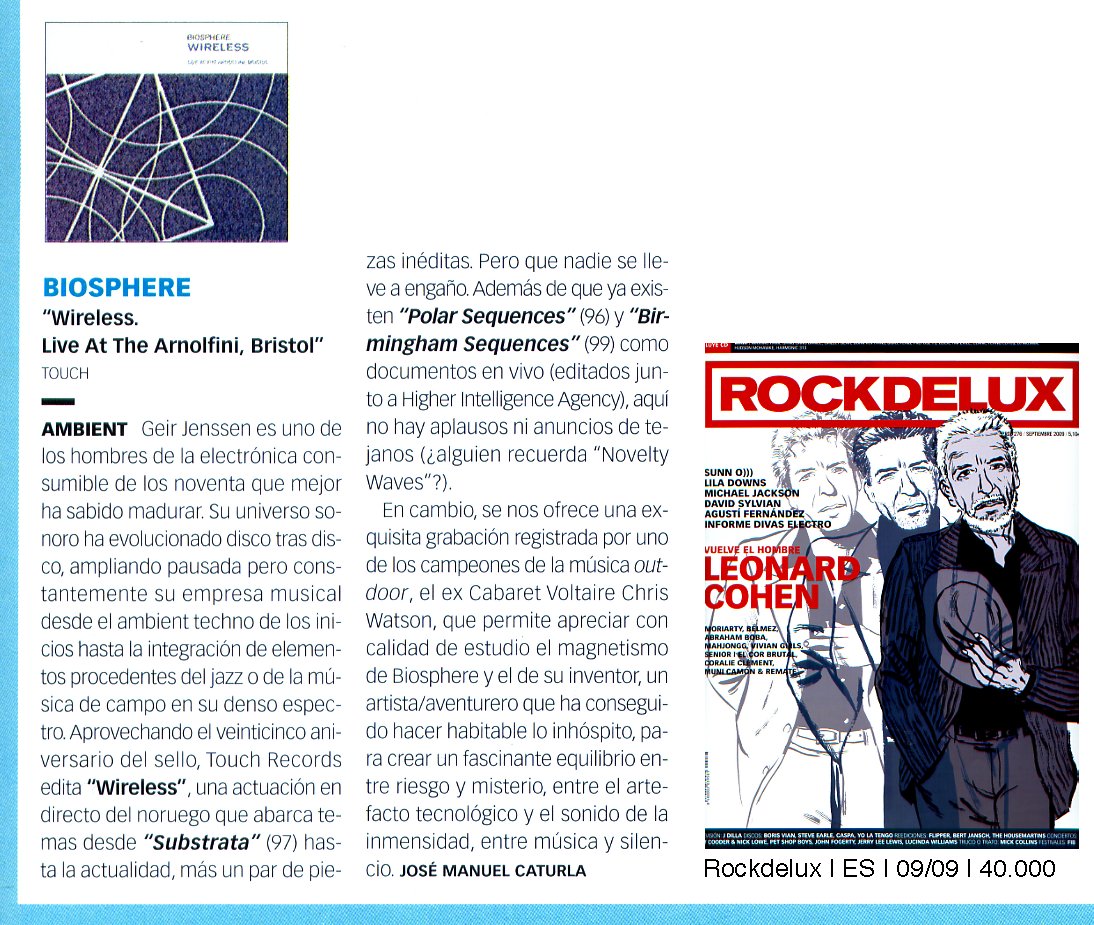
Gonzo Circus (Belgim):

Noise (France):

Feardrop (France):
Un concert de Biosphere n’est pas entièrement prévisible. Tournera-t-il à l’avantage du rythme ou de la texture, de la matière ou de l’harmonie ? Généralement, un ton se donne, se fixe ensuite pour guider l’heure de performance. Wireless déroge à cette règle que j’ai pu observer, peut-être en raison du caractère très spécial du festival lors duquel il a été représenté, pour les vingt-cinq ans du label Touch. En tant que musique à visée organique (et viser n’est pas atteindre à chaque fois), celle de Geir Jenssen / Biosphere se doit d’assimiler l’ensemble des éléments sonores qui la constituent, afin de dévoiler l’harmonie du corps élaboré. Si les morceaux joués sont pour la plupart des compositions déjà publiées en versions studio sur les albums précédents, leur présentation pour ce concert prend une pli plus ondulant qu’à l’habitude, dans l’esprit de ce corps précisément, dont ils deviennent des organes, comme ils ont été, autrement, ceux de l’album sur lequel ils ont été originellement publiés. C’est-à-dire qu’il a fallu repenser la masse globale de l’heure, l’accorder aux morceaux autant que les morceaux ont suivi son métabolisme. Ainsi, plusieurs tempéraments se chevauchent, se mêlent, fusionnent. Les abstractions surgissent en crêtes, comme affleurements, field recordings boisés, rocailleux, projetant les pièces dans une nature qui leur convient tout aussi bien que le studio dont ils montrent souvent la netteté. Une trompette également (Jony Easterby) vient apporter une autre lumière. Les boucles, on le sait, gardent leur propre amplitude, mais elles semblent aborder dans leur développement du moment, l’imprécision qui caractérise les régularités naturelles. Dès lors, les choix opérés durant les dernières années par Geir Jenssen prennent plus de sens encore : peu importe finalement pour lui que l’esthétique soit électronique, acoustique ou naturaliste, il les modèle dans un seul courant, son grand talent de compositeur s’y amuse des codes et confirme le sien tout en l’exposant au grand jour, au grand vent, à la poussée du paysage : les percussions liquides pleuvent, les boucles de cuivre sont nébuleuses, les charrois métalliques y soufflent, l’harmonie y est tout le paysage, et la mélodie se laisse pressentir, comme le langage dans ce qui ne parle pas encore. [Denis Boyer]
Black (Germany):
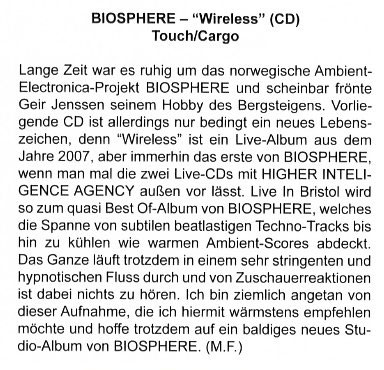
S&V (Russia):
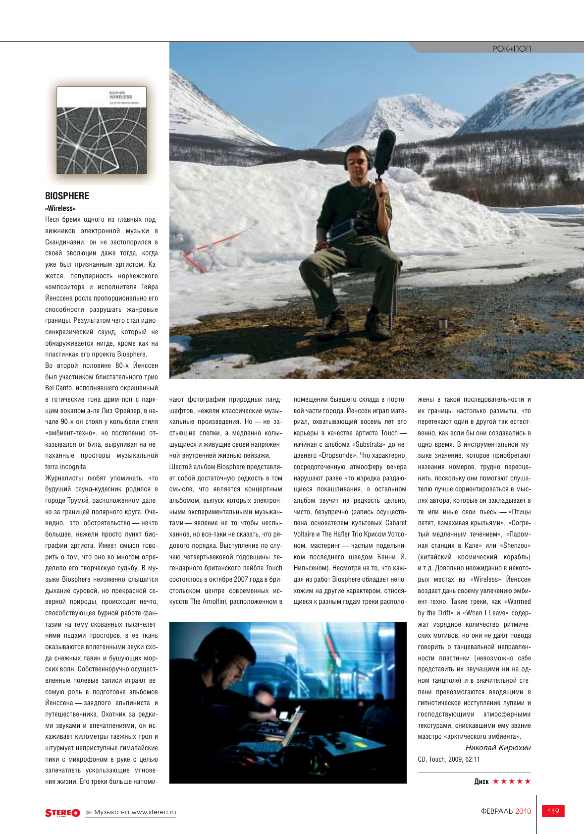
Fear Drop (France):
Un concert de Biosphere n’est pas entièrement prévisible. Tournera-t-il à l’avantage du rythme ou de la texture, de la matière ou de l’harmonie ? Généralement, un ton se donne, se fixe ensuite pour guider l’heure de performance. Wireless déroge à cette règle que j’ai pu observer, peut-être en raison du caractère très spécial du festival lors duquel il a été représenté, pour les vingt-cinq ans du label Touch. En tant que musique à visée organique (et viser n’est pas atteindre à chaque fois), celle de Geir Jenssen / Biosphere se doit d’assimiler l’ensemble des éléments sonores qui la constituent, afin de dévoiler l’harmonie du corps élaboré. Si les morceaux joués sont pour la plupart des compositions déjà publiées en versions studio sur les albums précédents, leur présentation pour ce concert prend une pli plus ondulant qu’à l’habitude, dans l’esprit de ce corps précisément, dont ils deviennent des organes, comme ils ont été, autrement, ceux de l’album sur lequel ils ont été originellement publiés. C’est-à-dire qu’il a fallu repenser la masse globale de l’heure, l’accorder aux morceaux autant que les morceaux ont suivi son métabolisme. Ainsi, plusieurs tempéraments se chevauchent, se mêlent, fusionnent. Les abstractions surgissent en crêtes, comme affleurements, field recordings boisés, rocailleux, projetant les pièces dans une nature qui leur convient tout aussi bien que le studio dont ils montrent souvent la netteté. Une trompette également (Jony Easterby) vient apporter une autre lumière. Les boucles, on le sait, gardent leur propre amplitude, mais elles semblent aborder dans leur développement du moment, l’imprécision qui caractérise les régularités naturelles. Dès lors, les choix opérés durant les dernières années par Geir Jenssen prennent plus de sens encore : peu importe finalement pour lui que l’esthétique soit électronique, acoustique ou naturaliste, il les modèle dans un seul courant, son grand talent de compositeur s’y amuse des codes et confirme le sien tout en l’exposant au grand jour, au grand vent, à la poussée du paysage : les percussions liquides pleuvent, les boucles de cuivre sont nébuleuses, les charrois métalliques y soufflent, l’harmonie y est tout le paysage, et la mélodie se laisse pressentir, comme le langage dans ce qui ne parle pas encore. [Denis Boyer]
Body Matters (Spain):
Em 1991 era editado Microgravity, álbum pioneiro, percursor da electrónica que ia conquistar a década. Ainda estavam longe os tempos em que o termo “IDM” se tornaria uma das mais debatidas siglas, um dos mais refutados rótulos, longe estava o tempo em que o subgénero “música de dança inteligente” se tornaria fenómeno de culto. Ainda não se sabia bem o que ali estava, nascia ali uma electrónica abstracta, herdeira directa do house que ameaçava penetrar o mainstream, mas que simultaneamente o rejeitava, que mostrava vontade de querer ser outra coisa. Música ritmada que não queria dançar, música feita de repetição, electrónica feita hipnose.
A confirmação veio com Patashnik, o segundo disco, de ’94. Ao longo dessa década Biosphere AKA Geir Jenssen tarbalhou uma revolução na sombra, quase silenciosa, mas com muitos resultados. O grande regresso ocorreu em 2004, com Autour de la Lune, mostrando-o em claros territórios ambientais, fazendo-nos crer em Jenssen como discípulo de Brian Eno – e estava ali um dos momentos mais memoráveis da sua carreira. Gravado ao vivo em 2007, na (amaldiçoada) cidade de Bristol, este novo Wireless é uma espécie de continuação e é a prova de vida de Biosphere, quase duas décadas depois da primeira edição.
Percursor das formas da electrónica que entretato foram tomando conta do mainstream, do minimal ao chill out (que depressa se tornou praga), Biosphere tem neste registo “live” uma amostra das múltiplas fases e experiências do seu percurso, que funciona como espécie de enciclopédia autobiográfica. Há batidas viciosas, texturas cortantes, sons robóticos, atmosferas geladas. Este “Live at the Arnolfini” mostra que a música de Jenssen consegue ser tão enigmática quanto a pintura de Van Eyck dissecada por Panofsky. Plena de detalhes, repleta de pormenores, que revelam informações sub-reptícias, ocultas ao ouvinte mais desprevenido. [Nuno Catarino]
Terz (Germany):
Und hier der Gegenpol: Das erste Livealbum von Geir Jenssen ist der unspektakuläre aber nachhaltige Meilenstein, der zu erwarten war. Aber warum? Nach der Besteigung des Cho Oyu-8000ers in Tibet und der draus resultierenden Audio-Exkursion von 2006 begab sich der Ambient-Tech-Pionier bereits Ende 2007 in Bristol in ein einstündiges Stück Audio, das aufgrund seiner vielfältigen und spannungsreichen Progression besser und faszinierender nicht sein kann. Der Grundgestus scheint klar: ruhige rhythmische Bewegung, aber die Stufen – von kristallin-hypnotisch über hochauflösend-gasförmig bis hin zu multispektral-psychedelisch – ergeben eine sagenhafte Reise, die sich mitzuerleben lohnt. [Honker]
Musique Machine (UK):
Biosphere is one of those names you hear about and think they’d be something you’d like but never get around to investigating. This album is a good opportunity to correct that. It’s a live album (Biosphere’s first) recorded at the Arnolfini in Bristol as part of the Touch 25. (25 (back in 2007) referring to the number of years Touch had been in existence). Touch have been keen to keep everything about this release “in house.” The concert was recorded by Chris Watson and the album mastered by BJ Nilsen and as you’d expect the cover is by Jon Wozencroft (though not in my opinion one of his better designs).
Musically you get a run through of Biosphere’s history with tracks taken from various parts of his 20 odd year career. The first and last tracks of the album are both pieces based around Trombone sounds which act as a good pair of bookends for the selections from the Biosphere catalogue. Whilst Geir Jenssen (the man behind Biosphere) works in a variety of styles, there is still very much a sense that all these pieces are by the same person. His music has a certain sound that makes it obvious all the pieces are by him even though they vary in content from Ambient Techno, to Cinematic soundtracks to some slightly more Avant Garde pieces.
Sound wise on the more ambient techno pieces you’re looking at warm soft synth sounds and drums that have a very long attack on them so they sound gentle and soothing rather than military and sharp. The nearest comparison I can make is to Seefeel (though type of sounds used is where the similarities end). The more cinematic pieces have a more orchestral basis to them, though presumably these are either samples or played on a keyboard.
In general it’s a fairly relaxed album to listen to. If I would want to pull it up over anything it would be that there are moments were you’re almost too relaxed and it almost borders on ambient elevator music. (It’s a long way away from the more challenging parts of the Touch roster). But thankfully those moments are few and for my first taste of Biosphere I find it pleasantly rewarding.










